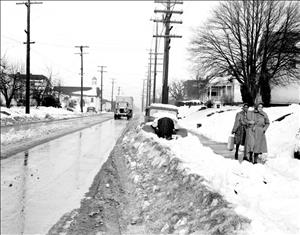On January 15, 1943, snow and a cold snap hits Puget Sound and is the worst cold weather in more than 20 years. War production ceases, schools and stores close, and the U.S. Army temporarily lifts restrictions on weather reports. On Friday, January 15, 1943, snow began falling throughout Puget Sound, but what was obvious to residents could not be reported in the media. Wartime restrictions on information prohibited weather reports. The Seattle Post-Intelligencer had some fun with the regulations.
"The thermometer changed its position more than somewhat Friday night and a lot of restricted military information fell in the streets of Seattle and vicinity early yesterday morning. The stuff looked like cornflakes, but for a few more hours, at least, we are not permitted to tell you whether it was cornflakes or not. We are not even permitted to tell you whether Lawrence C. Fisher, the weather man, reported for work yesterday morning with his great coat buttoned up to his neck. Mr. Fisher dresses with considerable caution these days, realizing that the amount and type of his attire may serve to tip off some skulking foreign agent of the weather possibilities within the forbidden interval."
Most of the humor ended there. The temperature dropped to 20 degrees Fahrenheit and the War Production Board declared a critical heating gas emergency. Householders were ordered not to use gas ovens, only stove burners, not to use hot water heaters, and to keep homes no warmer than 60 degrees Fahrenheit during the day and lower at night.
War plants, including the Boeing Co. at Boeing Field and in Renton, and shipyards in Seattle and Bremerton, ran out of natural gas and lost electric power on Monday, January 19, 1943. Assembly lines ground to a halt and idle workers went home. Fire departments were swamped with emergency calls from overheated furnaces and stoves. Stores closed early.
Seattle City Light and Puget Sound Power & Light reported that snow and ice broke power lines, darkening Queen Anne Hill, parts of Ballard, and all of the Harbor Island war industries. City Light Superintendent Eugene R. Hoffman took personal command of the repair efforts. "This is the worst storm in the history of City Light from the standpoint of damage done." The entire Puget Sound Power & Light service area east of Lake Washington lost power on Tuesday evening, January 20, 1943.
The cold contracted steel on Seattle's Spokane Street drawbridge leaving it stuck open, interrupting trolleys powered by electric lines that could not be rerouted. Other trolley runs were cancelled because stalled automobiles blocked the routes. Employees who depended on transit could not get to work. Food could not be delivered to grocery stores. Rail service was delayed.
Seattle schools closed on Wednesday, January 20, 1943. The following day, the temperature fell to six degrees Fahrenheit and it snowed more. High winds added to the discomfort. The University of Washington cancelled classes. Ferries were unable to land on Vashon Island, marooning residents there. Seattle City Light brought in 36 additional linemen from Spokane to assist in repairs. Many linemen had worked 36 hours straight.
No fatalities were reported, but 11 children were injured, one critically, in sledding accidents.
On Saturday, January 23, 1943, the U.S. Army re-imposed the restrictions on weather reporting, indicating an end to the emergency.

